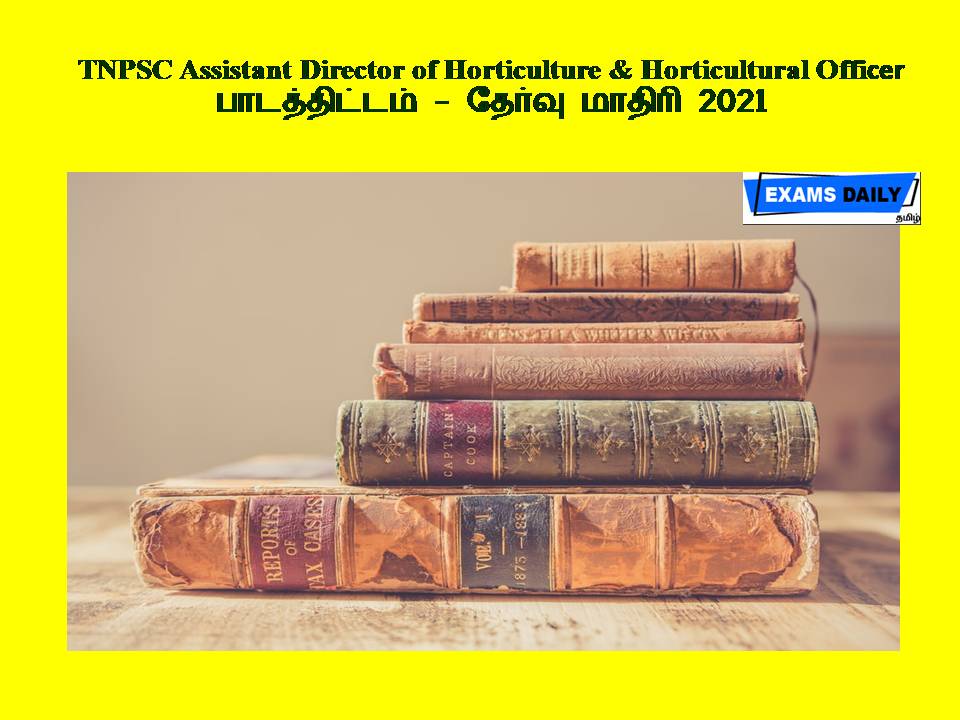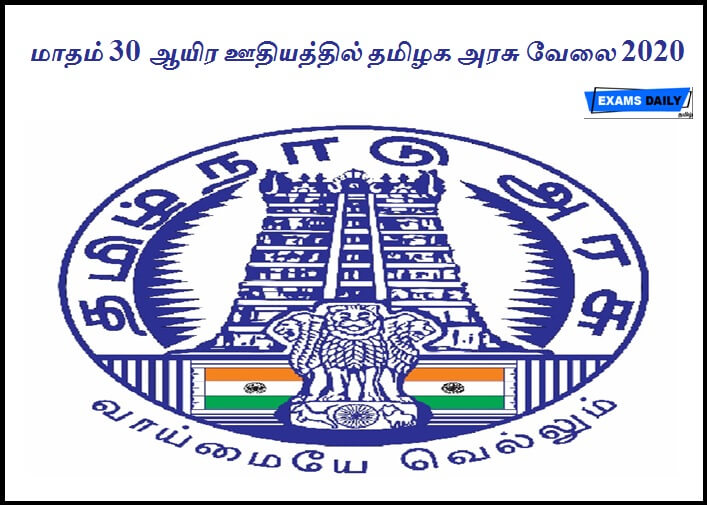TNPSC Assistant Director of Horticulture & Horticultural Officer Syllabus பாடத்திட்டம் – தேர்வு மாதிரி
தமிழ்நாடு அரசுப் பணியாளர் தேர்வாணையம் (TNPSC) ஆனது தமிழ்நாடு தோட்டக்கலை சேவை துறையில் காலியாக உள்ள Assistant Director of Horticulture and Horticultural Officer பணிகளுக்கு பணியிட செய்தி அறிவிப்பினை தற்போது வெளியிட்டு உள்ளது.
Assistant Director of Horticulture & Horticultural Officer Notification
அந்த செய்தி குறிப்பில் அறிவிக்கப்பட்டுள்ள படி, பதிவாளர்களுக்கு தேர்வுகள் நடைபெற உள்ளது. அதற்கு தயாராகும் விண்ணப்பதாரர்களுக்கு உதவிடும் வகையில் எங்கள் வலைதளத்தில் அத்தேர்வுகளுக்குரிய தேர்வு பாடத்திட்டம் மற்றும் தேர்வு மாதிரி ஆகியவற்றினை வழங்கியுள்ளோம்.

Horticultural Officer தேர்வு செயல்முறை :
பதிவு செய்வோர் Written Examination மற்றும் Oral Test செயல்முறைகள் மூலம் தேர்வு செய்யப்பட்டு பணியமர்த்தப்படுவர்.
TNPSC தேர்வு தேதி :
- Assistant Director of Horticulture பணிக்கு 18.04.2021 மற்றும் 19.04.2021 ஆகிய இரு தேதிகளில் தேர்வு நடைபெற உள்ளது.
- Horticultural Officer பணிக்கு 18.04.2021 அன்று எழுத்துத் தேர்வு நடைபெறும்.
TNPSC தேர்வு மாதிரி :
Assistant Director of Horticulture
| Subject | Duration | Marks |
| Paper I – P.G. degree | 3 Hours | 300 |
| Paper II – General Studies | 2 Hours | 200 |
| Interview and Records | – | 70 |
| Total | 570 | |
Horticultural Officer
| Subject | Duration | Marks |
| Paper I – Degree | 3 Hours | 300 |
| Paper II – General Studies | 2 Hours | 200 |
| Interview and Records | – | 70 |
| Total | 570 | |
TNPSC பாடத்திட்டம் :
Horticulture (P.G. Degree Standard)
UNIT- I: PRINCIPLES OF HORTICULTURE
- Scope and importance of horticulture – Scenario of horticulture industry in the regional, National and global economy – Area and production – Export and import – Nutritive value of horticultural crops – Horticultural therapy
UNIT – II: PROPAGATION AND NURSERY TECHNIQUES OF HORTICULTURAL CROPS
- Sexual propagation, principles, advantages and disadvantages – Apomixis, polyembryony, seed dormancy and methods to overcome the dormancy – Factors influencing seed germination – Protrays – Containers – Media
UNIT – III: GROWTH AND DEVELOPMENT OF HORTICULTURAL CROPS
- Important phases of growth and development – Definitions, photosynthetic productivity, leaf area index (LAI) – optimum LAI in horticultural crops. Canopy development: Different stages of growth, growth curves, growth analysis in horticultural crops
UNIT – IV: BREEDING OF HORTICULTURAL CROPS
- Scope and importance of plant breeding in horticultural crops – Breeding systems and objectives – Plant genetic resources – Modes of reproduction – Mechanisms of pollination control, sterility and incompatibility
UNIT – V: PRODUCTION TECHNOLOGY OF FRUIT CROPS
- Scope and importance – Current scenario on national and international level production and trade of fruit crops – Field gene bank and cryopreservation of fruit crops – Species – Varieties / hybrids – Climate and soil requirements
UNIT – VI: PRODUCTION TECHNOLOGY OF VEGETABLE CROPS
- Scope and importance of warm, cool and under exploited vegetable crops -Current scenario on national and international level of production and trade of vegetable crops – Types of vegetable farming – Commercial varieties / hybrids – Climatic and soil requirements – Seasons
UNIT – VII: PRODUCTION TECHNOLOGY OF COMMERCIAL FLOWER CROPS AND LANDSCAPING
- Scope and importance of floriculture industry – Loose flower production and trade – National and international status – Commercial varieties/ hybrids – Climatic and soil requirements – Field preparation – Season
UNIT – VIII: PRODUCTION TECHNOLOGY OF SPICES AND PLANTATION CROPS
- Scope and importance of spices and plantation crops – Present status – National and International trade – Climatic and soil requirements – Commercial varieties/hybrids – Season – Propagation – Sowing/planting
UNIT – IX: PRODUCTION TECHNOLOGY OF MEDICINAL AND AROMATIC CROPS
- Scope and importance of medicinal and aromatic plants. – Production and trade – National and International scenario of herbal and perfumery industry, WTO – Export and import status, Indian system of medicine, in situ and ex situ conservation. Classification o f medicinal andaromatic crops
UNIT – X: POST- HARVEST TECHNOLOGY OF HORTICULTURAL CROPS
- Scope and importance – National and Global scenario of post-harvest technology in horticultural crops – Harvest indices, harvesting methods in horticultural crops – Harvesting practices for specific market requirements – Influence of pre harvest factors on post harvest quality and shelf life of horticultural crops
Horticulture (Degree Standard)
UNIT- I: FUNDAMENTALS OF HORTICULTURE
- Scope and importance – State, National and Global scenario of horticultural crops – Area and production – Import and export – Nutritive value of horticultural crops – Horticultural zones of Tamil Nadu and India
UNIT – II: GROWTH AND DEVELOPMENT OF HORTICULTURAL CROPS
- Important phases of growth and development – Bearing habits – Classification of horticultural crops based on life cycle – Annual, biennial perennial (woody and herbaceous perennials) – Fruitfulness and unfruitfulness –
UNIT – III: PROPAGATION OF HORTICULTURAL CROPS
- Propagation – Definition – Establishment of nursery – Site selection – Tools and implements propagation structures – Mist chamber, phytotron – Humidifiers – Greenhouse – Glasshouse – Polyhouse – Shade net, glass house, poly tunnels, cold frames and hotbeds, pit nursery – Media and containers
UNIT – IV: MANAGEMENT TECHNIQUES FOR HORTICULTURAL CROPS
- Planning – Layout and management of orchards – Fencing – Wind breaks and shelter beds – Spacing – Planting system – Physical and chemical properties – Soil reaction – acid, saline and alkaline soils – Soil fertility – Essential elements –Functions – Organic manures and inorganic fertilizers
UNIT – V: PRODUCTION TECHNOLOGY OF FRUIT CROPS
- Scope and importance of fruit crops – Composition and uses – Origin and distribution – Species – Season – Climate and soil requirement – Varieties and hybrids – Propagation techniques – Planting systems and planting density
UNIT- VI: PRODUCTION TECHNOLOGY OF VEGETABLE CROPS
- Scope and importance of vegetable crops – Composition and uses – Origin and distribution – Area and production – Soil and climatic requirements – Varieties and hybrids – Propagation methods – Seed rate – Sowing and nursery practises – Containerized seedling production – Season
UNIT – VII: FLORICULTURE & LANDSCAPE GARDENING
- Scope and importance of flower crops production – Uses – Origin and distribution – Area and production – Climate and soil requirement – Species and varieties – Propagation, season – Spacing and planting methods – Irrigation, nutrient management – Fertigation – Weed management –
UNIT – VIII: PRODUCTION TECHNOLOGY OF SPICES AND PLANTATION CROPS
- Scope and Importance of spices and plantation crops – Composition and uses – Origin and distribution – Area and production – Climate and soil requirements – Species and varieties – Season, seed rate / propagation methods –Spacing – Planting system – High density planting – Irrigation and nutrient management
UNIT – IX: PRODUCTION TECHNOLOGY OF MEDICINAL AND AROMATIC CROPS
- Scope and importance of medicinal and aromatic crops – Composition and uses – Origin and distribution – Area and production – Ex situ and insitu conservation – Classification of medicinal and aromatic crops – Constraints in medicinal plant cultivation – Climate and soil– Varieties – Propagation – Nursery practices
UNIT – X: POST- HARVEST TECHNOLOGY OF HORTICULTURAL CROPS
- Importance of post-harvest handling in horticultural crops – Maturity indices – Post-harvest handling methods – Washing – Grading – Waxing – Grades and standards – Methods of packing
General Studies (Degree Standard/Objective Type)
UNIT-I: GENERAL SCIENCE
-
- Physics
- Chemistry
- Botany
- Zoology
UNIT- II: CURRENT EVENTS
-
- History
- Political Science
- Geography
- Economics
- Science
UNIT-III : GEOGRAPHY
- Earth and Universe – Solar system-Atmosphere hydrosphere, lithosphere – Monsoon, rainfall, weather and climate – Water resources
UNIT-IV: HISTORY AND CULTURE OF INDIA
- Pre-historic events -Indus valley civilization-Vedic, Aryan and Sangam age-Maurya dynastyBuddhism and Jainism-Guptas, Delhi Sultans, Mughals and Marathas-Age of Vijayanagaram and the bahmanis-South Indian history
UNIT-V: INDIAN POLITY
- Constitution of India – Preamble to the constitution- Salient features of constitution- Union, State and territory- Citizenship-rights amend duties- Fundamental rights- Fundamental duties- Human rights charter- Union legislature – Parliament- State executive- State Legislature – assembly
UNIT- VI: INDIAN ECONOMY
- Nature of Indian economy-Need for economic planning-Five-year plan models-an assessment-Land reforms & agriculture-Application of science in agriculture Industrial growth-Capital formation and investment-Role of public sector & disinvestment-Development of infrastructure-
UNIT-VII: INDIAN NATIONAL MOVEMENT
- National renaissance-Early uprising against British rule-1857 Revolt- Indian National Congress-Emergence of national leaders-Gandhi, Nehru, Tagore, Nethaji -Growth of militant movements
UNIT-VIII: APTITUDE AND MENTAL ABILITY TESTS
- Conversion of information to data-Collection, compilation and presentation of data – Tables, graphs, diagrams-Parametric representation of data-Analytical interpretation of data – Simplification-Percentage-Highest Common Factor (HCF)-Lowest Common Multiple (LCM)- Ratio and Proportion
TNPSC Syllabus PDF
| To Subscribe => Youtube Channel | கிளிக் செய்யவும் |
| To Join => Whatsapp | கிளிக் செய்யவும் |
| To Join => Facebook | கிளக் செய்யவும் |
| To Join => Telegram Channel | கிளிக் செய்யவும் |







